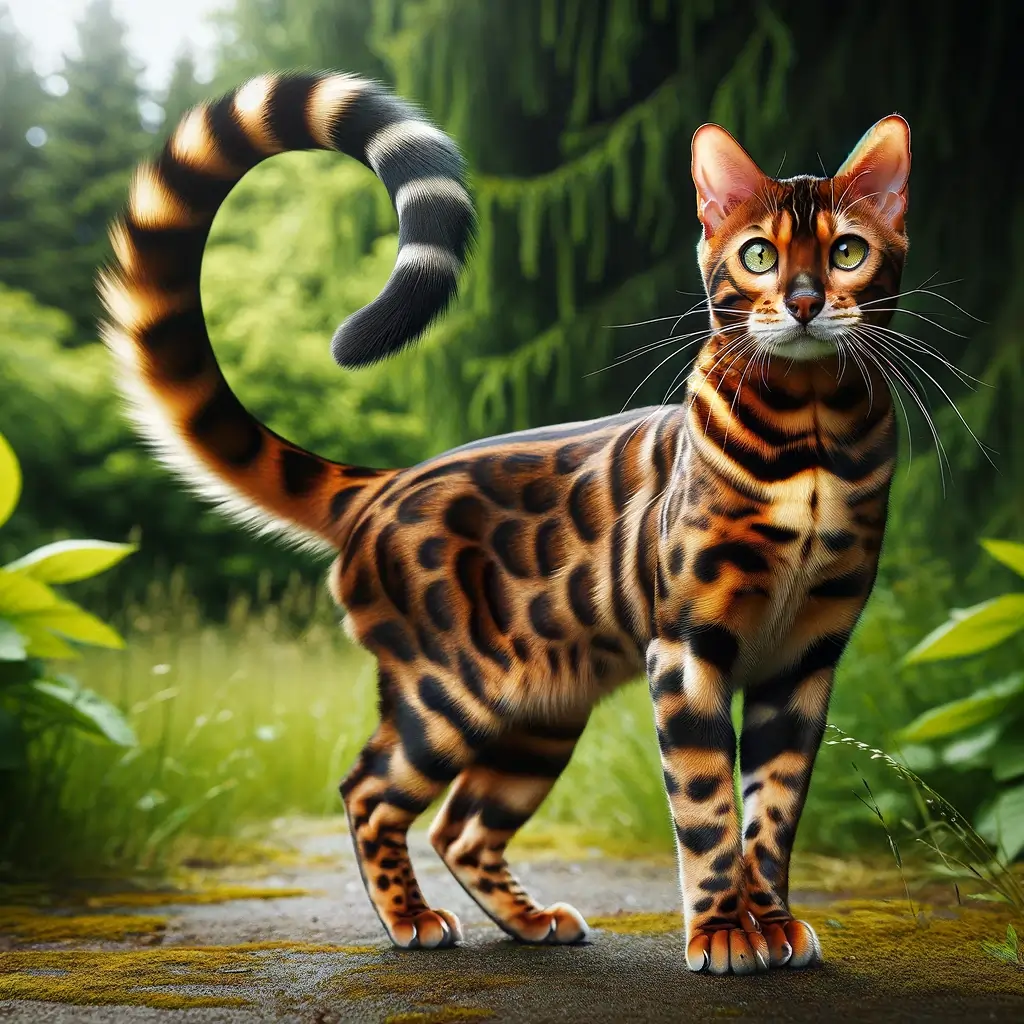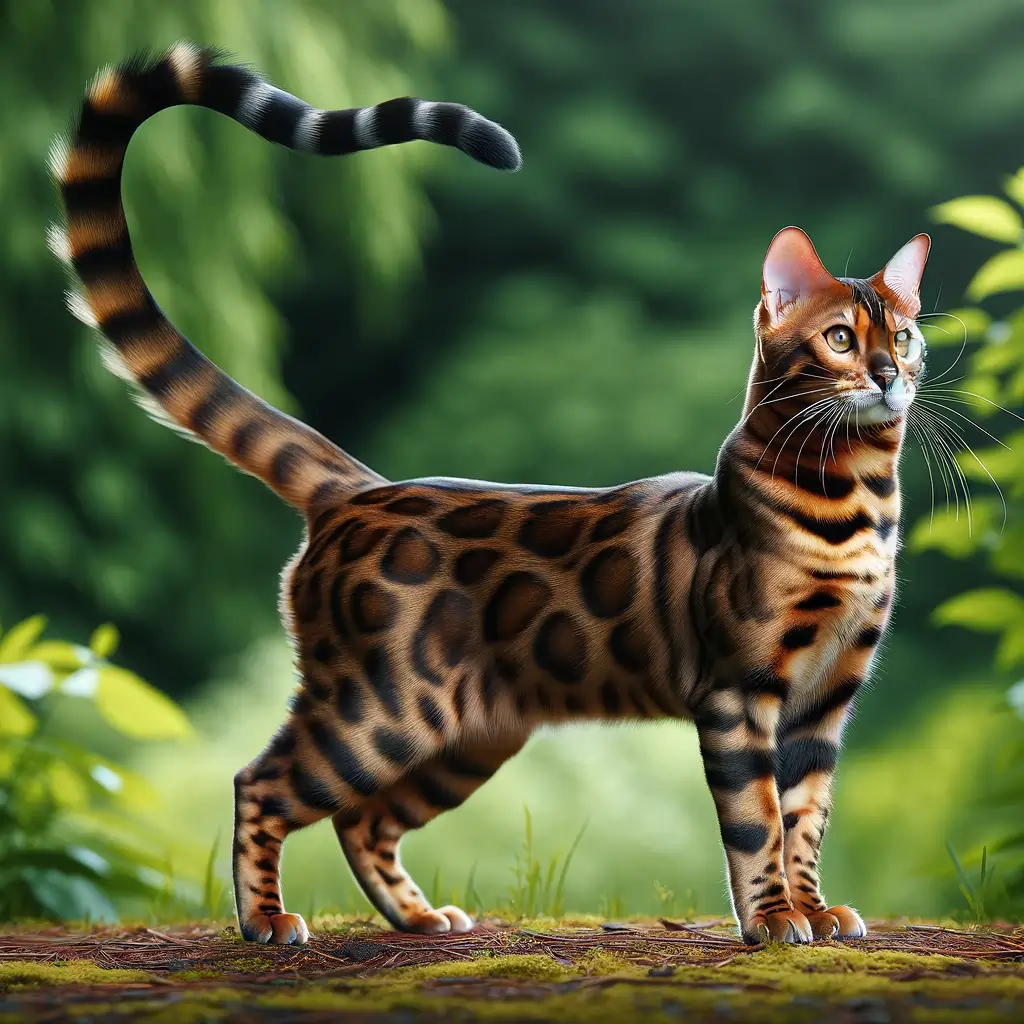In this article, we will explore the fascinating characteristics of Bengal cats‘ tails and answer the question, “Do Bengal cats have long tails?” Bengal cats are a unique breed known for their stunning appearance and active nature, and their tails are no exception.
Bengal cat tail markings vary from cat to cat, with no two being exactly alike. Their tails may have spots, stripes, or a combination of both, adding to their exotic appeal. But what about their length? Let’s delve deeper into Bengal cat tail length and markings to gain a better understanding of these remarkable feline companions.
Bengal Cat Tail Length and Markings
In this section, we will discuss the tail length and markings of Bengal cats. Bengal cats are known for their long and luxurious tails that contribute to their distinctive appearance. Compared to other cat breeds, Bengal cats have longer tails that they use for various purposes.
The length of a cat’s tail can vary depending on its breed and individual genetics. Domestic cats, for example, often have shorter tails compared to Bengal cats. The length of a Bengal cat’s tail is proportionate to their body size, serving as a visual representation of their elegance and grace.
Bengal cats use their tails not only for balance but also for communication. The tail serves as a tool for expressing emotions and intentions, allowing them to interact with other cats and humans. A Bengal cat’s tail can be seen wagging, twitching, or held upright, conveying messages such as playfulness, curiosity, or even agitation.
In addition to communication, the tail also plays a crucial role in a Bengal cat’s hunting instincts. When a Bengal cat is on the prowl, its long tail acts as a counterbalance, helping it maintain agility and precision. The tail aids in shifting weight and changing directions quickly, enabling the cat to pounce on its prey with accuracy.
Bengal cat tails are typically round and have a thick coat, adding to their overall beauty. The markings on the tail of a Bengal cat can vary, with some having spots or rosettes that resemble their wildcat ancestors. These unique tail markings contribute to the mesmerizing appearance of Bengal cats and make them stand out among other breeds.

The Role of the Bengal Cat’s Tail
When it comes to Bengal cats, their long tails play an important role in both communication and balance. Bengal cats have long tails just like most other cat breeds, and these tails serve multiple functions in their daily activities.
Communication
One of the primary ways Bengal cats use their tails is for communication. Cats, including Bengal cats, can convey various emotions and messages through their tail movements. For example, a twitching or wagging tail can indicate excitement or playfulness, while a puffed-up tail can signal aggression or fear.
Bengal cats may use their tails to communicate not only with other cats but also with their human owners. A gently swaying tail may indicate contentment and relaxation, while a lashing tail could indicate annoyance or agitation.
Balance and Agility
The Bengal cat’s tail also plays a crucial role in maintaining balance and agility. Their tails are usually thicker and more muscular compared to other cat breeds, allowing them to check their movements and make quick adjustments while in motion.
Bengal cats use their tails as a counterbalance, helping them maintain stability and land on their feet even when performing acrobatic jumps or maneuvers. The length and thickness of their tails provide the necessary support and coordination during these agile movements.
Comparison to Other Cat Breeds
While Bengal cats’ tails are typically thick and fluffy, some other cat breeds may have longer or shorter tails. For example, Manx cats are known for their bobtail trait, where their tails may be missing or significantly shorter. On the other hand, some breeds may have longer tails than Bengal cats.
The length and thickness of a cat’s tail can vary depending on the breed in question, and sometimes even within a specific breed. However, Bengal cats tend to have tails that are in proportion to their body size, neither excessively long nor excessively short.
| Cat Breed | Length of Tail | Thickness of Tail |
|---|---|---|
| Bengal Cats | Varies, but usually in proportion to body size | Thicker and more muscular compared to other cat breeds |
| Manx Cats | May have longer or shorter tails due to the bobtail trait | Tail length is dependent on individual cat |
| Other Cat Breeds | Length can vary, some breeds may have longer tails | Tail length is dependent on the individual cat |
Conclusion
In conclusion, Bengal cats are known for their distinctive and genetically determined long tails, which serve multiple important functions. The length and thickness of a Bengal cat’s tail can vary among individuals but are generally proportional to their body size. Understanding the unique characteristics of Bengal cats’ tails can provide valuable insights into their behaviors and breed traits.
The long tail of Bengal cats plays a crucial role in communication, balance, and hunting abilities. It is an essential tool for expressing emotions and intentions, allowing them to agitate, pounce, and defend themselves effectively. Additionally, their tails closely interact with their sense of smell, enhancing their ability to perceive and respond to scents in their environment.
Bengal cats are known for their playful nature, and their long tails contribute significantly to their agility and coordination. They use their tails as a counterbalance while climbing, running, and engaging in playful activities. However, it’s important to note that Bengal cats’ tails can also be injured, such as sprains or ligament strains, due to their active and energetic lifestyle.
Overall, the distinctive traits of Bengal cats’ tails, influenced by genetics and environmental context, are a key feature that sets them apart from other cat breeds. Their long tails not only enhance their physical abilities but also add to their charm and character. Whether it’s their playful nature, defensive display, or expressive communication, the Bengal cat’s tail truly embodies their unique breed and adds to their captivating allure.

Hey guys, My name is Simon Smith. I’m from Canada and live near Victoria
I live with my sweet family and have 20+ Ragdolls of different types. I love them as my own children. My profession is as a hotel manager.
I love to keep Ragdolls and grow their breeder case. I have 7 years of experience.
I’m an expert in cat care. So, I’m here to provide you with new information about my cats daily. This is my personal blog website, so I request that you kindly visit our site daily.
If you’re a Ragdolls lover and you have any questions or confusion about cats, text me on the Contact Us page or Gmail.
Thank u
